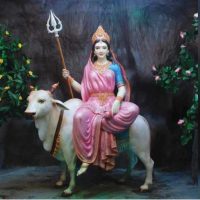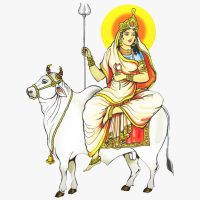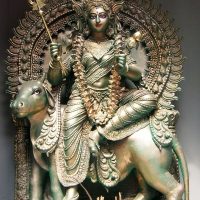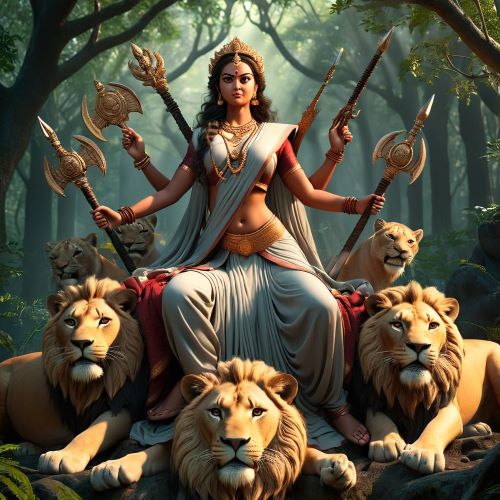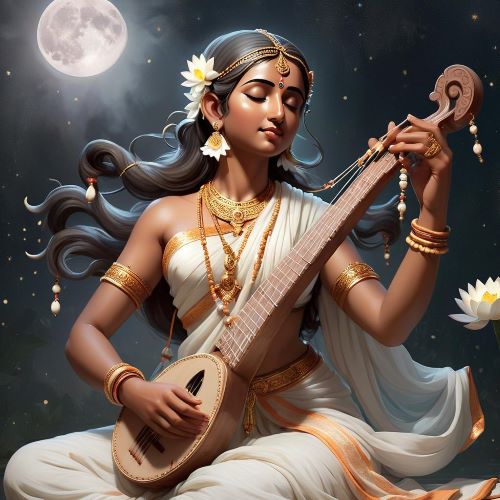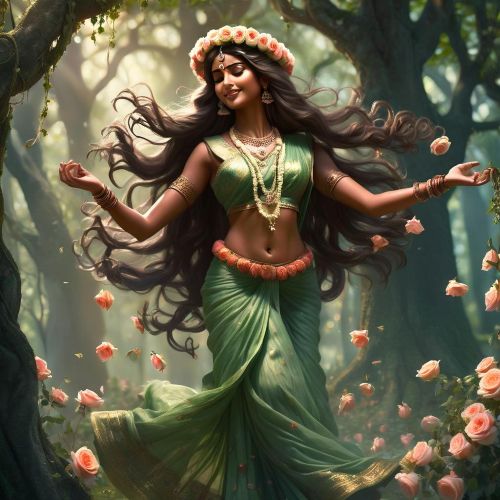Shailaputri : The Mountain Born Goddess
Listen
At a glance
| Description | |
|---|---|
| Origin | Indian Mythology |
| Classification | Gods |
| Family Members | Himavat (Father), Menavati (Mother) |
| Region | India |
| Associated With | Strength, Renewal, Mountains |
Shailaputri
Introduction
Shailaputri (शैलपुत्री), literally meaning “Daughter of the Mountain,” is the first among the Navadurgas, the nine sacred forms of Goddess Durga worshipped during Navratri. She represents the primal source of divine energy, anchoring the spiritual journey that devotees undertake during this festival. Worship of Shailaputri takes place on the very first day of Navratri, symbolizing the beginning of spiritual awakening and the activation of inner strength. Her story is deeply rooted in Hindu mythology, where she bridges the tale of Sati, who sacrificed her life, and her rebirth as Parvati, destined once again to unite with Lord Shiva. Through this cycle of birth and transformation, Shailaputri embodies purity, endurance, and the eternal power of feminine energy.
Physical Traits
Shailaputri is depicted in Hindu iconography with a serene yet powerful form that communicates both maternal grace and divine authority. She rides upon Nandi, the sacred bull, whose presence symbolizes stability, loyalty, and strength of purpose. In her right hand, she carries a trident, or Trishul, which represents the power to destroy ignorance and the three fundamental aspects of existence—creation, preservation, and destruction. In her left hand, she holds a lotus, a symbol of purity and transcendence, which conveys her association with wisdom and spiritual blossoming.
A crescent moon rests upon her forehead, emphasizing her connection to cosmic cycles and the rhythm of time. Her attire is simple and earthy, reflecting her Himalayan origin and her deep connection with nature. This imagery captures her dual essence—she is both nurturing and fierce, embodying qualities necessary for the protection and sustenance of the universe. For devotees, the very sight of her icon is meant to inspire courage, purity, and steadfastness in spiritual practice.
Family
The story of Shailaputri cannot be understood without tracing her past and rebirth. In her earlier life, she was known as Sati, the daughter of Daksha Prajapati and Queen Prasuti. Sati’s deep devotion to Lord Shiva led to her marriage with him, but her life took a tragic turn when Daksha organized a grand yajna and insulted Shiva by not inviting him. Unable to bear the humiliation inflicted on her husband, Sati immolated herself in the sacrificial fire. This act became one of the most poignant moments in Hindu mythology, symbolizing devotion, sacrifice, and the price of dishonor.
Sati was later reborn as Parvati, the daughter of King Himavat, the personification of the Himalayas, and Queen Menavati. This rebirth gave her the name Shailaputri, meaning “daughter of the mountain.” As Parvati, she once again pursued Shiva with determination, undergoing rigorous penance to win him as her consort. Their eventual union restored the balance of cosmic energies, uniting Shakti and Shiva as the eternal pair. Together, they are parents to Lord Ganesha and Lord Kartikeya, both central figures in Hindu worship. Shailaputri’s lineage thus ties her not only to the cycle of rebirth but also to the origins of divine families in Hindu belief.
Other names
Shailaputri is celebrated under many names across different traditions and texts, each emphasizing a particular aspect of her identity. In her former incarnation, she was Sati, remembered for her unwavering devotion and ultimate sacrifice. After her rebirth, she came to be known as Parvati, the gentle and nurturing goddess of the mountains. The name Bhavani highlights her role as the giver of life and sustainer of natural cycles, while Hemavati refers directly to her Himalayan origins. She is also called Shailaja, meaning “born of the mountain,” and Girija or Girijaputri, both of which affirm her connection to the Himalayas.
Each of these names carries a layer of symbolic meaning, underscoring her link with fertility, nature, devotion, and cosmic balance. They also reflect the way her story has traveled across centuries, adapting to local traditions while maintaining her central role in the pantheon of Hindu goddesses.
Powers and Abilities
As the first form of Durga, Shailaputri represents the foundational strength needed for spiritual growth. Her powers are drawn from her association with the Muladhara Chakra, the root chakra in yogic philosophy, which governs stability, grounding, and the initiation of spiritual energy. Worship of Shailaputri is believed to awaken this chakra, laying the groundwork for a devotee’s spiritual ascent.
Her trident is a reminder of her ability to conquer obstacles and to protect her devotees from harm. The lotus she carries reflects her capacity for purity and renewal even in adverse conditions. By embodying both fierce energy and gentle compassion, Shailaputri balances destruction with creation, reminding worshippers of the dual forces required to maintain harmony in life.
She is also regarded as a reservoir of combined divine powers, encompassing attributes of Brahma, Vishnu, and Shiva. This makes her an all-encompassing force of the universe. Spiritually, she offers protection to her devotees, granting courage to face hardships and resolve to overcome negative influences. In astrology, she governs the Moon, and her blessings are believed to help pacify afflictions caused by lunar imbalances, often linked to mental well-being and emotional stability.
Modern Day Influence
In today’s world, the worship of Shailaputri continues to inspire millions, particularly during Navratri, where she is invoked on the very first day. Rituals like Ghatasthapana, the establishment of the sacred pot symbolizing fertility and life force, are performed in her honor. Devotees often fast, offer ghee, milk-based foods, and perform prayers that align them with her grounding energy.
Beyond religious rituals, Shailaputri has become a cultural symbol of resilience and empowerment. Her unwavering devotion to Shiva and her ability to rise again after tragedy inspire narratives of perseverance in modern contexts. She is increasingly viewed as an archetype of strength for women, representing independence, self-determination, and the courage to pursue goals against all odds.
In literature and popular culture, Shailaputri and her forms are reimagined in contemporary settings, often used to address themes of gender, social justice, and the challenges of modern life. Her story resonates with those who seek balance between tradition and progress, serving as a reminder of the enduring relevance of mythological archetypes.
In the realm of yoga and meditation, practitioners invoke her energy to activate the root chakra, grounding themselves before embarking on higher spiritual practices. Her symbolism continues to shape art, music, and even digital spaces, where her imagery is widely shared during Navratri as a reminder of the divine feminine.
Thus, Shailaputri’s significance extends far beyond the boundaries of mythology. She is not only a goddess of ancient worship but also a living symbol of strength, purity, and spiritual awakening, whose influence remains deeply embedded in the cultural and spiritual fabric of India.
Related Images
Source
Wikipedia contributors. (2023). Shailaputri. Wikipedia. Retrieved from https://en.wikipedia.org/wiki/Shailaputri
Indian Mythology Stories. (n.d.). What is the story behind Goddess Shailaputri?. Retrieved from https://indianmythology.co.in/what-is-the-story-behind-goddess-shailaputri/
Hinduism Outlook. (n.d.). Everything you need to know about Goddess Shailaputri. Retrieved from https://www.hinduismoutlook.com/maa-shailaputri-story-mantra/
Bhattacharyya, N. N. (1964). Indian Mother Goddess. Birchandra State Central Library,Tripura. https://www.semanticscholar.org/paper/adf5ce389544985a5f57dae59ae11feab9b4a5a0
The Hindu Goddess Shailputri, Uma Parvati – – Lotus Sculpture. (2012). https://www.lotussculpture.com/blog/hindu-goddess-shailputri-parvati/?srsltid=AfmBOooRwfPB_GHcCzMYaam_z1xaax3zhztR_nwsg3iB30uS0iWXSE1H
Shailaputri Devi ( Navratri First Day Goddess) – Rudraksha Ratna. (n.d.). https://www.rudraksha-ratna.com/articles/shailputri-devi?srsltid=AfmBOoqfM5PIrwUlTDW7zjG0ZB_2nlA9FOOzpKs1lHl3L0G1sz4B8Lzw
Frequently Asked Questions
What is lorem Ipsum?
I am text block. Click edit button to change this text. Lorem ipsum dolor sit amet, consectetur adipiscing elit. Ut elit tellus, luctus nec ullamcorper mattis, pulvinar dapibus leo.
What is lorem Ipsum?
I am text block. Click edit button to change this text. Lorem ipsum dolor sit amet, consectetur adipiscing elit. Ut elit tellus, luctus nec ullamcorper mattis, pulvinar dapibus leo.
What is lorem Ipsum?
I am text block. Click edit button to change this text. Lorem ipsum dolor sit amet, consectetur adipiscing elit. Ut elit tellus, luctus nec ullamcorper mattis, pulvinar dapibus leo.
What is lorem Ipsum?
I am text block. Click edit button to change this text. Lorem ipsum dolor sit amet, consectetur adipiscing elit. Ut elit tellus, luctus nec ullamcorper mattis, pulvinar dapibus leo.
What is lorem Ipsum?
I am text block. Click edit button to change this text. Lorem ipsum dolor sit amet, consectetur adipiscing elit. Ut elit tellus, luctus nec ullamcorper mattis, pulvinar dapibus leo.



